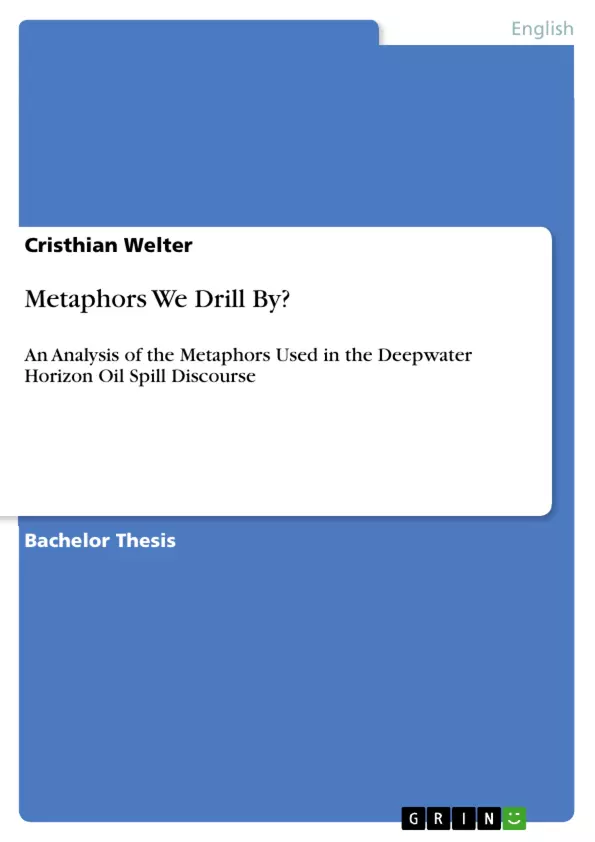The Deepwater Horizon Oil Spill has caused an ecological disaster of unknown magnitude. In this respect, the institutions involved in this incident did not have a good standing in public. As the major party responsible for the accident, BP has been criticized heavily by the people and the government. The White House, although not directly responsible, is also held accountable for the disaster by many folks. These two organizations have had to engage in an uphill battle against the media and especially the public. Both have made attempts to ease the tensions and to confront the criticism put forward by the American people as well as the global community. BP and the White House have made use of speeches and remarks to establish a connection between them and the people. In these speeches, officials from BP and the President of the United States, respectively, have made it their goal to inform the public about the latest happenings concerning the Deepwater Horizon Oil Spill and their response efforts. Every event of such magnitude is an opportunity for certain parties involved to present themselves from their best side, and is therefore exploited accordingly. In this respect, the speeches serve as linguistic tools to communicate certain images that are intended to be conveyed by their speakers.
With this in mind, this paper will analyze the speeches published by BP and the Obama Administration, respectively. The ultimate goal is to find out what metaphors are used in the speeches and what images are conveyed through their use. It was suggested that both parties have specific agendas that could be uncovered by looking at the use of specific metaphors. What can these metaphors and their conveyed images tell the hearer about these agendas? Are there certain agendas that the respective parties want to push at all? All of these questions mark the essence of this paper. First, in order to understand the metaphor per se, several theories are presented, all with their individual approaches to metaphors. In this section, the Literature Review chapter, the questions of what a metaphor does, how it does it and its function are answered according to their respective interpretations. Second, the Deepwater Horizon Oil Spill will be looked at in more detail in the Background chapter. Third, the methodological setup will be explained. The results of the analysis and their discussion, and interpretation can be found in chapters 5 and 6, respectively.
Inhaltsverzeichnis (Table of Contents)
- Introduction
- Literature Review
- Metaphors
- Metaphor Theories
- Aristotle & Traditional Theories
- Interaction View of Metaphor
- Lakoff's & Johnson's Approach to Metaphor
- Background
- Methodology
- Sample
- Data Collection & Analysis
- Results & Discussion
- OIL SPILL AS ENEMY
- REMOVING OIL IS WAR
- OIL SPILL AS DISEASE
- OIL SPILL AS MISTAKE
- THE WHITE HOUSE AS ENFORCER/THE WHITE HOUSE AS HELPER
- BP AS RESPONSIBLE HELPER
- Interpretation
- Limitations of Study
- Summary
Zielsetzung und Themenschwerpunkte (Objectives and Key Themes)
This paper aims to analyze the speeches published by BP and the Obama Administration regarding the Deepwater Horizon Oil Spill with a focus on the metaphors used. The goal is to uncover the specific images conveyed by these metaphors and explore the potential agendas behind their use.
- The use of metaphors in public discourse, particularly in speeches concerning environmental disasters.
- The relationship between metaphors and the speaker's intended message.
- The role of metaphors in shaping public perception and influencing opinion.
- The potential agendas of BP and the White House in their communication about the oil spill.
- The impact of metaphors on the public understanding of environmental issues.
Zusammenfassung der Kapitel (Chapter Summaries)
The Introduction provides an overview of the Deepwater Horizon Oil Spill, outlining its significance and highlighting the controversies surrounding BP and the White House's responses.
The Literature Review delves into the concept of metaphors, exploring their role in language and examining various theoretical perspectives on their function and impact.
The Background chapter provides detailed information on the Deepwater Horizon Oil Spill, exploring its causes, consequences, and the ongoing efforts to mitigate its impact.
The Methodology section outlines the sample, data collection methods, and analysis techniques used in the study.
The Results & Discussion chapter presents the findings of the analysis, focusing on the different metaphors used in the speeches and their respective implications.
The Interpretation chapter delves deeper into the analysis, exploring the potential agendas behind the use of specific metaphors and their impact on the public's understanding of the situation.
Schlüsselwörter (Keywords)
This paper explores the use of metaphors in the context of the Deepwater Horizon Oil Spill, analyzing speeches by BP and the White House to understand their communication strategies and the potential agendas behind their use of metaphors. Key concepts explored include metaphor theory, public discourse, environmental communication, and the impact of language on public perception.
- Citation du texte
- Cristhian Welter (Auteur), 2010, Metaphors We Drill By?, Munich, GRIN Verlag, https://www.grin.com/document/163631



